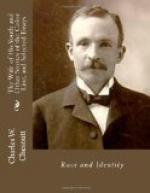“I know,” he would say, “that the white people lump us all together as negroes, and condemn us all to the same social ostracism. But I don’t accept this classification, for my part, and I imagine that, as the chief party in interest, I have a right to my opinion. People who belong by half or more of their blood to the most virile and progressive race of modern times have as much right to call themselves white as others have to call them negroes.”
Mr. Clayton spoke warmly, for he was well informed, and had thought much upon the subject; too much, indeed, for he had not been able to escape entirely the tendency of too much concentration upon one subject to make even the clearest minds morbid.
“Of course we can’t enforce our claims, or protect ourselves from being robbed of our birthright; but we can at least have principles, and try to live up to them the best we can. If we are not accepted as white, we can at any rate make it clear that we object to being called black. Our protest cannot fail in time to impress itself upon the better class of white people; for the Anglo-Saxon race loves justice, and will eventually do it, where it does not conflict with their own interests.”
Whether or not the fact that Mr. Clayton meant no sarcasm, and was conscious of no inconsistency in this eulogy, tended to establish the racial identity he claimed may safely be left to the discerning reader.
In living up to his creed Mr. Clayton declined to associate to any considerable extent with black people. This was sometimes a little inconvenient, and occasionally involved a sacrifice of some pleasure for himself and his family, because they would not attend entertainments where many black people were likely to be present. But they had a social refuge in a little society of people like themselves; they attended, too, a church, of which nearly all the members were white, and they were connected with a number of the religious and benevolent associations open to all good citizens, where they came into contact with the better class of white people, and were treated, in their capacity of members, with a courtesy and consideration scarcely different from that accorded to other citizens.
Mr. Clayton’s racial theory was not only logical enough, but was in his own case backed up by substantial arguments. He had begun life with a small patrimony, and had invested his money in a restaurant, which by careful and judicious attention had grown from a cheap eating-house into the most popular and successful confectionery and catering establishment in Groveland. His business occupied a double store on Oakwood Avenue. He owned houses and lots, and stocks and bonds, had good credit at the banks, and lived in a style befitting his income and business standing. In person he was of olive complexion, with slightly curly hair. His features approached the Cuban or Latin-American type rather than the familiar broad characteristics of the mulatto, this suggestion of something foreign being heightened by a Vandyke beard and a carefully waxed and pointed mustache. When he walked to church on Sunday mornings with his daughter Alice, they were a couple of such striking appearance as surely to attract attention.




